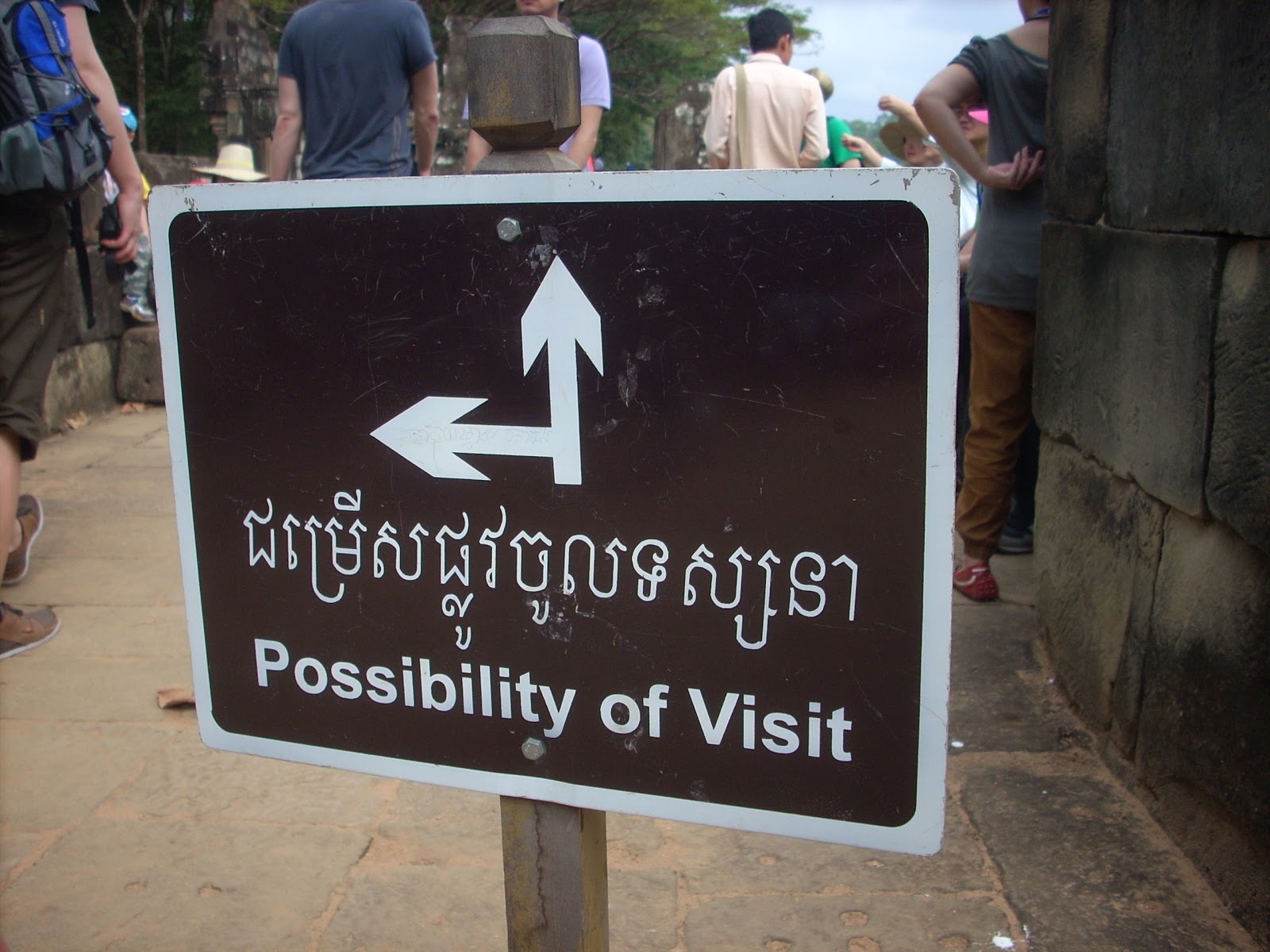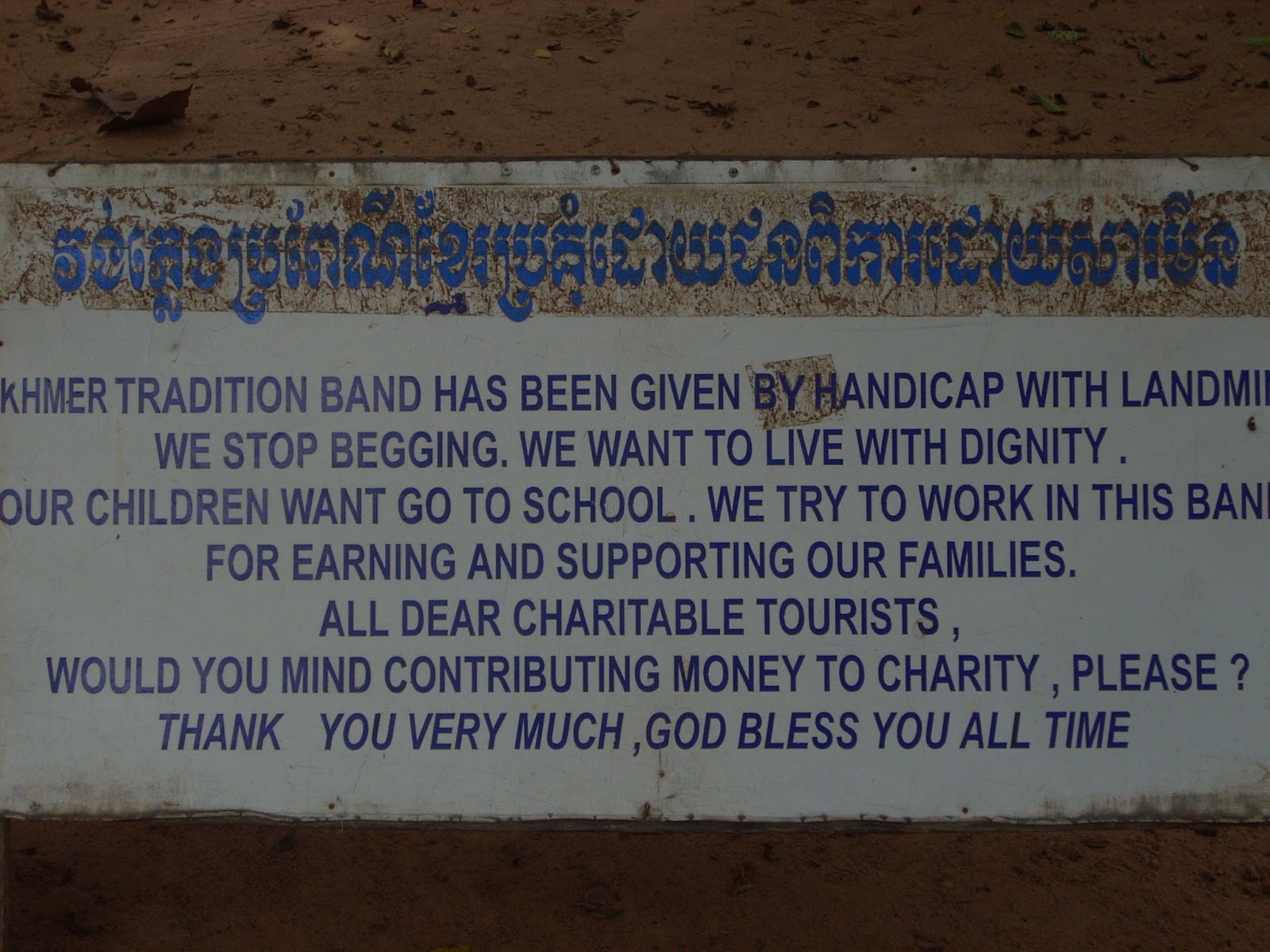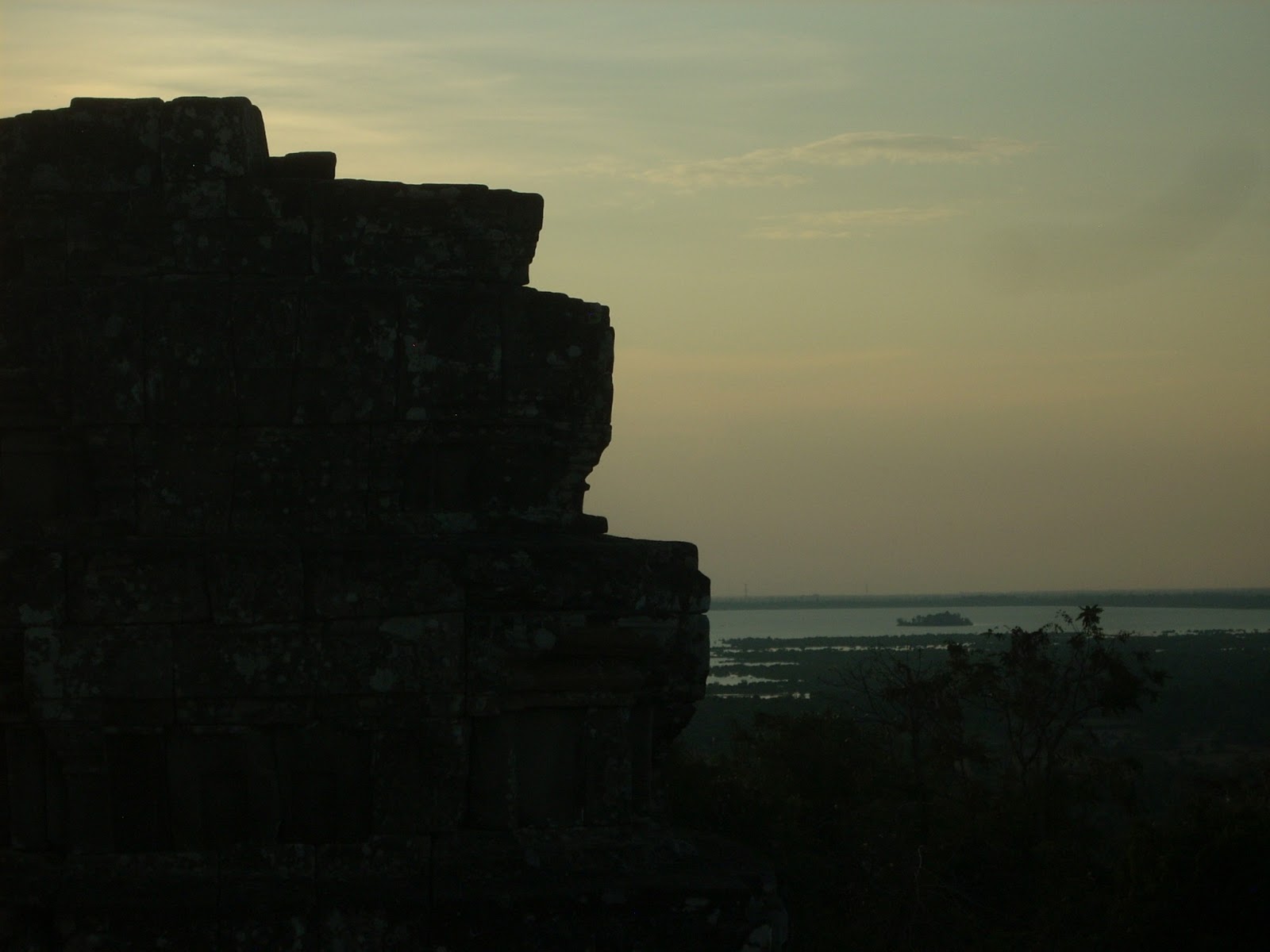 |
| Angkor Thom - Hidden Buddha |
A lot has happened here... and the spirits are not yet at peace.
According to my Dad's memoirs, around 1970, during our time in Vientiane, my brother came home one day and said, "Hey, guess what? Our class is going to take a trip to Angkor Wat. We're going to fly down on Royal Air Lao..." Dad's reaction was less than enthusiastic. "You WHAT? Whose *@#! idea was THAT?!" 'Since Royal Air Lao planes were unsafe even sitting in the hangar, and Angkor Wat was infested with NVA, Viet Cong, and Khmer Rouge, that flap was over before it even started. A certain teacher got a lecture on the realities of Southeast Asia...'"
For almost all of these last 40 years, Cambodia has suffered unimaginable hardships - bombing by the Americans during the war, the genocidal terror of Pol Pot's rule, and the running battle with the Vietnamese for control. If PTSD is something one can diagnose in a soldier, imagine a whole nation suffering from the effects of indescribable trauma. There is a reality here that very few Americans can truly absorb. I know I can't. I think we can only learn, and pay respect, and do what we can to help.
Lloyd got us booked on an Angkor Wat tour for our first full day in Cambodia, after flying into the city of Siem Reap from Luang Prabang. Flying in, we could see the huge Tonle Sap Lake, and the magnificent barays, reservoirs, built by the Khmer Empire in its heyday. Flat, misty land, with grass, rice and forested areas stretched to the more mountainous north. We could sense that vision of the past - but once we landed, it was gone.
Our driver was waiting for us, with a name sign. And of course, before we got to the hotel along the paved highway to Siem Reap, Jules had the life story of the driver. He was Thai, and had come to Siem Reap for more of a future (that was an eye-opener!). He was learning English, working as a guide, and was taking classes at a college. He felt there was less competition for jobs here than in Thailand. But Jules found out the more personal reason. He had been jilted by his long-time girlfriend in Thailand, and wanted a change of scenery. We wished him much luck on all endeavors.

So, forty years after the cancelled field trip, Jules and I have finally gotten here to Angkor Wat. Us, and everyone else. Visitors number in the millions per year, and we were part of that number now.
This was the road in. Jules and I were signed up with a tour group of about 10 people, mostly Australians. Bus from hotel, bus from crowded ticketing area, and then on foot with our guide. The photo shows the stream of locals coming in to work at Angkor, and the tourist wave hitting at the same time. The air smelled of dust and diesel fumes, and any spirit voices were drowned out by honking, multi-lingual chatter, and motorbike engines.
 This is a work day, if you are lucky.
This is a work day, if you are lucky.
Visiting with the monks near the entrance to Angkor Thom was a good way to get our heads straight, calm down, and get the smile in place.


 |
| Five towers of Angkor Wat and Moat |
We walked up through the compound of Angkor Thom first, then wound our way back through Angkor Wat, and many of the other ruins. I won't give you all the history and architectural information here - there are much better sources for that. Here are images, and a few stories.



The waterworks are an engineer's dream. Far more advanced than anyone suspected, recent discoveries have shown a vast network of water channeling and storage than enabled the civilization to keep a stable food supply.

The hallways have no roofs now, but the artwork carved into the walls still tells the stories of warfare and celebration of victories from the Hindu epic Mahabharata.
 |
| The Tomb Raider Tree at Ta Prohm |
Which was really ironic to hear, since the two ladies actually left the tour for a couple of hours due to hang-overs. But they did catch us up later, so maybe that gets them some gnar points.
Jules and I couldn't really contest their claims, after reading that an American had just died in Vang Vieng - imbiding and tubing are not a good combination.
These folks were a great bunch to tour with, always cheerful and living in the moment!

Elephant Terrace, where elephants were trained and parades held.

Jules, being a dancer, was looking for Apsaras everywhere. These lovely ceremonial dancers were the icon of Angkor. They were carved in many different styles over the centuries, but always delicate and balanced, each more graceful than the one before.
We did a LOT of climbing up and down. Very steep climbing, and getting around the larger varieties of Europeans without offending became a game of strategy. Jules and I aren't exactly long legged people, so it was a welcome workout.


 STRANGLER FIGS. These trees are endlessly fascinating. They are a real problem for the archaeologists trying to preserve the Angkor ruins, since they grow through the stone, cracking and crushing the blocks. The trees only live a couple hundred years, and can then topple, bringing down whole sections of walls. The dilemma is how to remove them without damaging the stonework. Sometimes, the tree is the only thing holding it all together.
STRANGLER FIGS. These trees are endlessly fascinating. They are a real problem for the archaeologists trying to preserve the Angkor ruins, since they grow through the stone, cracking and crushing the blocks. The trees only live a couple hundred years, and can then topple, bringing down whole sections of walls. The dilemma is how to remove them without damaging the stonework. Sometimes, the tree is the only thing holding it all together.And if you love the organic, fractal look of them, it's hard to think about killing them!


There were place that had their own special beauty, even in destruction.


And there are always those stairs and doorways that are irresistible. We were not allowed to go down there. It was really pretty amazing that we were able to clamber all over most of these ruins, and I doubt that will be the case much longer.
 We were always looking for the edge of the forest, wondering what remains to be discovered outside the groomed boundaries.
We were always looking for the edge of the forest, wondering what remains to be discovered outside the groomed boundaries. There is plenty, and as Cambodia stabilizes, more and more clearing and excavation is occurring. What a great time to be a young archaeologist!
I wonder, too, what it's like here in the rainy season. Probably perfect - quiet, calm, and the air would smell of forest and not diesel.
 Realities of the warfare are easy to spot. Here at Angkor Wat, we strolled through the cool echoing galleries where stone Buddhas and Hindu Gods resided. Pol Pot's Communist guerrillas destroyed these at every opportunity. Buddha still has dignity, even headless.
Realities of the warfare are easy to spot. Here at Angkor Wat, we strolled through the cool echoing galleries where stone Buddhas and Hindu Gods resided. Pol Pot's Communist guerrillas destroyed these at every opportunity. Buddha still has dignity, even headless.
 Bullet holes were visible in many parts of the walls and pillars.
Bullet holes were visible in many parts of the walls and pillars.  The human toll of the long years of war cannot be measured. I watched as some Chinese tourists, Europeans, and Australians passed by these musicians, possibly suspicious that they might be less than authentic. But it's no gimmick. In Cambodia Now: Life in the Wake of War, Karen Coates describes the lives of these men as they have had to cope with their injuries in a nation that is struggling to overcome a crippling past itself.
The human toll of the long years of war cannot be measured. I watched as some Chinese tourists, Europeans, and Australians passed by these musicians, possibly suspicious that they might be less than authentic. But it's no gimmick. In Cambodia Now: Life in the Wake of War, Karen Coates describes the lives of these men as they have had to cope with their injuries in a nation that is struggling to overcome a crippling past itself.
The band sounded really good, too - traditional tunes, played with pride.
The landmines and UXO problem is still severe, but improving. And in the meantime, we pay the dollar every time to hear a tune or two.
 Our last stop for the day was the traditional sunset view of off Phnom Bakheng, the 9th century state temple of the first Khmer capital. But it wasn't the history that drew the monks, the Chinese New Year tourists, and the school groups - it was the view. We could see the Angkor Wat complex, the West Baray, and forests extending north. We watched the sun go down over the countryside, with smokey haze from cooking fires in the far-off villages.
Our last stop for the day was the traditional sunset view of off Phnom Bakheng, the 9th century state temple of the first Khmer capital. But it wasn't the history that drew the monks, the Chinese New Year tourists, and the school groups - it was the view. We could see the Angkor Wat complex, the West Baray, and forests extending north. We watched the sun go down over the countryside, with smokey haze from cooking fires in the far-off villages.I wish there was a way to convey it. It was peaceful here. The few who lasted til sunset were quiet, and tired; happy to just sit and gaze. As the night's cicadas began, and the moisture rose from the ground, we started to feel we were in Cambodia as it has been for a thousand years.

 We headed back to our van, feeling as if we had been here for a long time - just the first day. Tomorrow, we had a new adventure planned, that would put us in that countryside, and even coated with it. We will find the older Cambodia, and the Laos I remembered too.
We headed back to our van, feeling as if we had been here for a long time - just the first day. Tomorrow, we had a new adventure planned, that would put us in that countryside, and even coated with it. We will find the older Cambodia, and the Laos I remembered too.



No comments:
Post a Comment